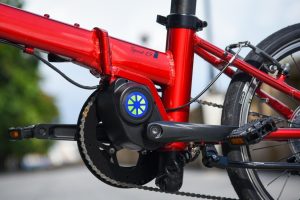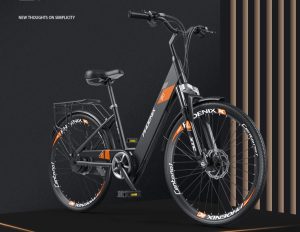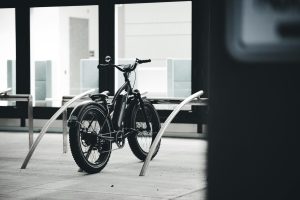As the “heart” of an electric ebike, the motor’s performance directly shapes your riding experience—core factors influencing climbing ability, battery life, and handling feel are precisely the motor type. Faced with a sea of technical jargon, newcomers often feel overwhelmed. This article breaks down motor working principles, compares mainstream types, and outlines ideal use cases to help you navigate the options and find your perfect match.
一、The Core Working Principle of Ebike Motor
Most modern e-bikes use brushless DC motors (BLDC), which eliminate the carbon brushes of traditional brushed motors. They rely on magnetic interaction between the stator (electromagnetic poles with copper windings) and the rotor (a permanent magnet ring) to generate rotation. This brushless design reduces friction, enhancing efficiency and durability. When current flows through the stator coils, electromagnetic poles attract or repel the rotor’s permanent magnets, driving its rotation and powering the wheels via the drivetrain. The controller regulates output, adjusting power dynamically based on pedaling force or throttle input for a natural, smooth assist.
二、Comparison of Mainstream Motor Types and Their Use Cases
E-bike motors are primarily categorized by installation position into three types: front hub motors, rear hub motors, and mid-drive motors. Each type has distinct performance strengths and limitations.
1. Front Hub Motors: The Entry-Level “Pull-Type” Power
- Structure & Experience: Mounted inside the front wheel hub, they generate forward pull by driving the front wheel, creating a pseudo “all-wheel drive” feel. While the front-wheel force might initially feel slightly unusual, they’re straightforward to operate and ideal for beginners.
- Advantages:
- Easy Installation: Independent of the drivetrain, simplifying tire changes or maintenance;
- Balanced Weight: If the battery sits in the middle or rear of the frame, it creates even weight distribution.
- Cost-Effective: Lower manufacturing costs make them budget-friendly.
- Limitations:
- Reduced Traction: The lighter front-wheel load increases slippage risk on gravel, slopes, or rough terrain;
- Power Constraints: Fork design limits high torque output, best suited for flat or gently hilly routes.
- Ideal For: Urban commuting beginners, casual riders, and those who prefer easy maintenance.
2. Rear Hub Motors: The Classic “Push-Type” Workhorse
- Structure & Experience: The most common type, rear hub motors sit in the rear wheel hub, driving the bike by pushing the rear wheel—mimicking the natural feel of traditional bicycle propulsion.
- Advantages:
- Strong Traction: The rear wheel carries more weight, improving grip and reducing spinouts;
- Wide Power Range: Available from low-power commuter models to high-power sport versions, adapting to diverse scenarios;
- Throttle Compatibility: Supports pure electric drive (where legal), enabling direct, responsive acceleration.
- Limitations:
- Complex Maintenance: Integrated with rear wheel gears, requiring simultaneous handling of motor components during inner tube replacement or gear adjustments;
- Weight Concentration: Rear battery placement may overload the rear, affecting maneuverability.
- Ideal For: Daily commuters, long-distance riders, and those seeking a traditional riding feel.
3. Mid-Drive Motors: The “All-Round” Champion for Hills and Rough Terrain

- Structure & Experience: Positioned near the bottom bracket, they drive the chain directly through the bike’s gear system, delivering a “rider-motor unity” experience with dynamic assist.
- Advantages:
- Superior Torque: Leveraging the bike’s gear system, low gears amplify torque for effortless climbing on steep slopes;
- Balanced Weight: Centralized mass improves stability and handling on complex terrain;
- High Energy Efficiency: Direct chain drive reduces energy loss from speed conversion in hub motors.
- Limitations:
- Higher Cost: Requires custom frame integration, making whole bikes pricier than hub motor models;
- Maintenance Demands: Chain-driven power may accelerate wear on gears and chains, necessitating regular upkeep of high-quality drivetrain components;
- Learning Curve: Requires coordination with the gear system, demanding adaptation for new users.
- Ideal For: Mountain bikers, frequent hill climbers, and advanced riders seeking high performance and control.
三、Niche Motor Types: Innovative Designs for Specialized Needs
Beyond mainstream options, niche motors cater to specific scenarios:
- Integrated Wheel Motors: Combine motor, battery, and even controller in a single hub for minimalism, but concentrated weight may disrupt balance;
- Friction-Drive Motors: Use a rubber wheel pressed against the tire for simple, low-cost drive, but limited power and reliant on tire condition;
- Belt-Drive Motors: Mid-drive alternatives to chains, offering quiet operation and no lubrication, though less durable under heavy use.
四、How to Choose Your Perfect Motor?
- Prioritize Riding Scenarios:
- Flat Urban Roads: Front/rear hub motors suffice; choose front for budget, rear for traditional feel;
- Hills/Mountains: Mid-drive motors excel via gear system torque amplification;
- Cargo/Heavy Loads: Rear hub or mid-drive (high torque) handle extra weight better.
- Balance Maintenance and Budget:
- Low Maintenance: Front hub (simple structure) or belt-drive (no lubrication);
- Best Value: Rear hub motors;
- Performance Investment: Mid-drive (for long-term heavy use).
- Adhere to Regulations and Habits:
- Check local laws on throttle use—some regions restrict pure electric drive to pedal-assist only;
- Opt for rear hub (throttle-compatible) for electric-only riding, front/mid-drive for pedal-assist preference.
Conclusion
There’s no one-size-fits-all “best” e-bike motor; the key is alignment with your needs. Beginners may start with simple front/rear hub motors, while advanced riders or rugged terrain users should invest in mid-drive systems. Understanding each type’s power characteristics, maintenance demands, and use cases ensures your motor enhances—rather than hinders—your riding experience.
With rational analysis and test rides, you’ll surely find the ideal “heart” for your e-bike, powering every journey with confidence!




